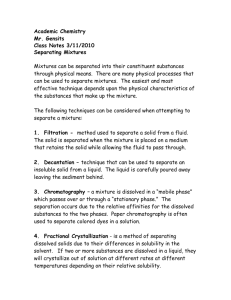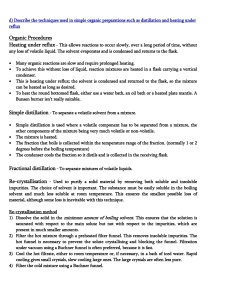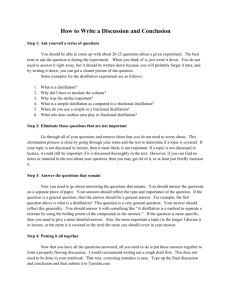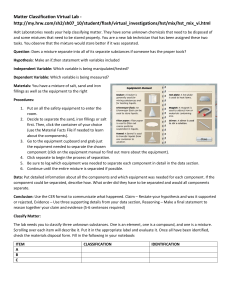METHODS OF SEPARATION: EVAPORATION: 1. This method is
advertisement
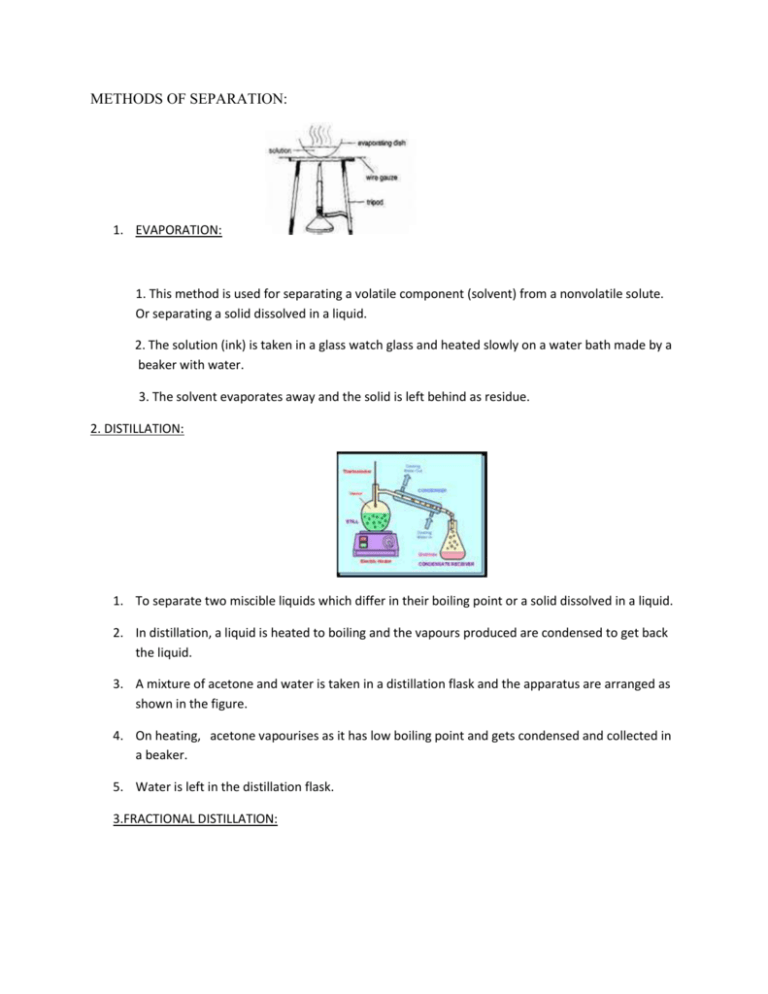
METHODS OF SEPARATION: 1. EVAPORATION: 1. This method is used for separating a volatile component (solvent) from a nonvolatile solute. Or separating a solid dissolved in a liquid. 2. The solution (ink) is taken in a glass watch glass and heated slowly on a water bath made by a beaker with water. 3. The solvent evaporates away and the solid is left behind as residue. 2. DISTILLATION: 1. To separate two miscible liquids which differ in their boiling point or a solid dissolved in a liquid. 2. In distillation, a liquid is heated to boiling and the vapours produced are condensed to get back the liquid. 3. A mixture of acetone and water is taken in a distillation flask and the apparatus are arranged as shown in the figure. 4. On heating, acetone vapourises as it has low boiling point and gets condensed and collected in a beaker. 5. Water is left in the distillation flask. 3.FRACTIONAL DISTILLATION: 1. This method is used to separate two or more miscible liquids whose boiling points differ less than 25 K. 2. The apparatus is similar to the simple distillation. There is a fractionating column fitted between the distillation flask and condenser. 3. A fractionating column is a glass tube packed with glass beads which provide surface for the vapours to cool and condense rapidly. 4. When the mixture is heated the vapours of more volatile component ascend into the fractionating column condenses and trickles down and the less volatile component trickles back in to the distillation flask. 5. Thus the mixture is separated. 4.CHROMATOGRAPHY: 1. This method is used to separate those solutes of a mixture which are soluble in the same solvent. 2. A strip of chromatographic paper is taken and a drop of ink is put on it and the paper is left to dry. 3. Now the chromatographic paper is kept in water taken in a beaker in such a way that only the tip of the paper touches the water. 4. We can observe that as the solvent rises up through the paper the different components of ink reaches different heights based on their solubility. 5. The more soluble components move faster, while the less soluble component follows it. 5.USING SEPARATING FUNNEL: 1. It is used to separate the components of a mixture of two immiscible liquids. 2. The mixture is taken in a separating funnel and allowed to stand. 3. The liquid with more density will form a lower layer while the liquid with less density forms the upper layer. 4. The stopcock is opened and the lower layer is carefully drained out in a beaker. 5. Example: oil from water or ether from water. 6.CENTRIFUGATION: 1. Colloidal solutions in which the components are not separated by simple filtration are separated by this method. 2. The mixture is taken in centrifuge tubes, kept in holders and rotated rapidly. 3. Solids are settled down at the bottom and leaving the supernatant liquid at the top which is separated by decantation. 7.FILTRATION: 1. This process is used to separate a liquid from solid. 2. The mixture is allowed to pass through a filter paper and the liquid passes through the pores leaving the solid as residue on the filter paper. 3. The filtered liquid is known as filtrate. This method is used to separate sand from water. 8. SUBLIMATION: 1. This method is used when one of the components of the mixture vaporises without melting. 2. On cooling the vapours directly change in to solid. 3. A mixture of ammonium chloride and common salt is taken in a china dish. 4. The dish is covered with an inverted funnel with a cotton plug at the narrow opening of the funnel. 5. On heating the dish, ammonium chloride sublimes and collects on the walls of the funnel. 9. CRYSTALLISATION: 1. This method is used to purify solids. The processes by which pure solid in the form of crystals are separated from a saturated solution. 2. A hot saturated solution of the solid is made in a suitable solvent. 3. This hot saturated solution on cooling, the solid crystals are separated which are filtered out. 10. SEPARATION OF COMPONENTS OF AIR: 1. The constituents of air can be separated by fractional distillation. 2. The air is compressed by increasing pressure and is then cooled to get liquid air. 3. This liquid air is allowed to warm up slowly in a fractional distillation column where gases are separated at different heights depending upon their boiling points. 4. First CO2 separates as dry ice, then O2 ( b.p -1830c), Ar ( b.p -1860c ) and N2 ( -1960c).

